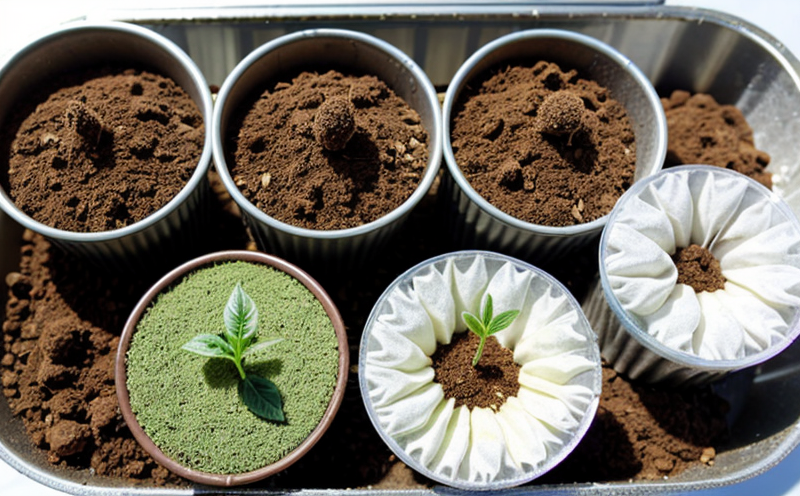Drought Stress Germination Testing
In agriculture and forestry testing, ensuring seed quality is critical to achieving successful crop yields. One of the most important aspects of this process is drought stress germination testing. This testing method evaluates how seeds perform under water-stressed conditions, simulating real-world scenarios where drought could impact plant growth.
Drought stress can significantly affect seed viability and subsequent plant performance. By subjecting seeds to controlled water deprivation, we can assess their ability to survive and germinate in conditions that may occur during periods of limited rainfall or extended dry spells. This testing is particularly valuable for crops and tree species known to be vulnerable to drought.
The test typically involves placing the seeds in a controlled environment where they are subjected to varying degrees of water stress. The level of stress can range from mild, moderate, to severe conditions. Seed samples are then incubated under these conditions while being monitored closely for germination rates and vigor indices. This allows for precise evaluation of how different seed lots respond to environmental stresses.
For accurate results, the testing protocol must be stringent and reproducible. International standards such as ISO 6397-1:2005 provide guidelines on methods used in agricultural seeds testing that can guide these protocols. Compliance with these standards ensures reliability and consistency across different laboratories.
The importance of this test cannot be overstated, especially for regions prone to droughts or those looking to introduce new crop varieties that are more resilient to such conditions. It helps breeders select seed lots that possess better tolerance to water stress, thereby enhancing overall agricultural productivity and sustainability.
- Seed lots with higher germination rates under drought stress conditions are likely to produce crops capable of thriving in harsher environmental conditions.
- This testing also aids in the development of improved irrigation strategies by providing insights into how much water is truly necessary for optimal growth.
- The results from these tests contribute significantly to understanding climate change impacts on agriculture and forestry, helping researchers develop more robust plant varieties.
Ultimately, drought stress germination testing plays a crucial role in ensuring agricultural resilience against climatic challenges. By incorporating this method into their quality assurance programs, organizations can better prepare for future environmental uncertainties and maintain sustainable practices.
Customer Impact and Satisfaction
Drought stress germination testing offers substantial benefits to various stakeholders within the agricultural sector:
- Breeders: They gain valuable insights into which seed lots exhibit superior drought tolerance, allowing for targeted breeding programs aimed at developing more resilient crops.
- R&D Engineers: The data obtained from these tests can be used to refine models that predict crop performance under different environmental conditions, leading to improved product development.
- Quality Managers: They ensure consistent quality by verifying that seeds meet specified standards even when faced with adverse environmental factors like drought.
- Compliance Officers: Adherence to international standards ensures regulatory compliance and builds trust among consumers regarding the reliability of products.
The testing process not only enhances product quality but also contributes positively towards achieving sustainability goals. Farmers who rely on seeds tested through this method report increased crop yields and reduced losses due to environmental stressors. This translates into greater profitability for them, which in turn satisfies both suppliers and buyers alike.
International Acceptance and Recognition
Drought stress germination testing has gained international recognition as a crucial tool in ensuring agricultural productivity across diverse climatic zones. Organizations like the International Seed Testing Association (ISTA) and the American Society for Testing and Materials (ASTM) have established protocols that standardize this type of testing.
These organizations promote uniformity in methods, which facilitates easier comparison between test results from different laboratories worldwide. Compliance with these standards enhances credibility and trust among global markets. For instance, many countries require imported seeds to undergo such tests before being approved for planting within their borders.
The acceptance of drought stress germination testing extends beyond mere compliance; it fosters innovation by encouraging research into developing more resilient plant varieties. Laboratories that adhere to international standards are often preferred partners by large agricultural corporations and government agencies due to the reliability and consistency they offer.
Environmental and Sustainability Contributions
Drought stress germination testing plays a vital role in supporting sustainable agriculture practices. By identifying seeds that perform well under water-stressed conditions, this process helps reduce dependency on excessive irrigation systems which are both resource-intensive and environmentally unfriendly.
Additionally, selecting drought-tolerant varieties can lead to reduced water usage per unit of crop yield, contributing to efficient use of natural resources. This aligns with broader efforts towards minimizing environmental impact while maximizing productivity.
The testing also supports conservation initiatives by aiding in the preservation of native species that are naturally adapted to arid conditions. By prioritizing these seeds for cultivation, we promote biodiversity and protect ecosystems against degradation caused by climate change.
Furthermore, drought stress germination tests contribute towards reducing food waste by ensuring only viable seeds reach farmers' fields. This increases overall efficiency in the agricultural supply chain from seed production all the way to harvest.





